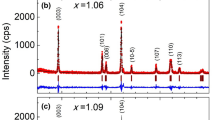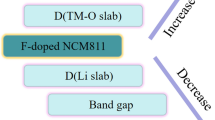Abstract
The thermodynamic stability is a very important quantity for the electrode materials, because it is not only related to the electrochemical performances of the materials but also the safety issue of the cells. To evaluate the thermodynamic stability of Li x Ni0.5Mn1.5O4 (x = 0, 1), the formation enthalpies from elemental phases and oxides were obtained. The values for LiNi0.5Mn1.5O4 were calculated to be −1341.10 and −141.84 kJ mol−1, while those for Ni0.5Mn1.5O4 were −949.11 and −49.21 kJ mol−1. These values are much more negative than those of LiCoO2 and LiNiO2 compounds, indicating that the thermodynamic stability of Li x Ni0.5Mn1.5O4 is better than the two classic compounds. To clarify the microscopic origin, the density of states, magnetic moments, and bond orders were systematically investigated. The results showed that the excellent thermodynamic stability of LiNi0.5Mn1.5O4 is attributed to the absence of Jahn-Teller distortions, strong electrostatic interactions of Li–O ionic bond, and strong Ni–O/Mn–O ionic-covalent mixing bonds. After lithium extraction, the disappearance of the pure Li–O bonds leads to an increase of formation enthalpy, indicating a decreasing thermodynamic stability for Ni0.5Mn1.5O4 with respect to LiNi0.5Mn1.5O4.




Similar content being viewed by others
References
Zhang Q, Uchaker E, Candelaria SL, Cao G (2013) Nanomaterials for energy conversion and storage. Chem Soc Rev 42:3127–3171
Gong Z, Yang Y (2011) Recent advances in the research of polyanion-type cathode materials for Li-ion batteries. Energy Environ Sci 4:3223–3242
Liu HP, Wen GW, Bi SF, Gao P (2015) Enhanced rate performance of nanosized Li4Ti5O12/graphene composites as anode material by a solid state-assembly method. Electrochim Acta 171:114–120
Cheng J, Li X, Wang Z, Guo H (2016) Hydrothermal synthesis of LiNi0.5Mn1.5O4 sphere and its performance as high-voltage cathode material for lithium ion batteries. Ceram Int 42:3715–3719
Gao ZG, Sun K, Cong LN, Zhang YH, Zhao Q, Wang RS, Xie HM, Sun LQ, Su ZM (2016) High performance 5 V LiNi0.5Mn1.5O4 spinel cathode materials synthesized by an improved solid-state method. J Alloys Compd 654:257–263
Monaco S, Giorgio FD, Col LD, Riché M, Arbizzani C, Mastragostino M (2015) Electrochemical performance of LiNi0.5Mn1.5O4 composite electrodes featuring carbons and reduced graphene oxide. J Power Sources 278:733–740
Patoux S, Sannier L, Lignier H, Reynier Y, Bourbon C, Jouanneau S, Cras FL, Martinet S (2008) High voltage nickel manganese spinel oxides for Li-ion batteries. Electrochim Acta 53:4137–4145
Kunduraci M, Al-Sharab JF, Amatucci GG (2006) High-power nanostructured LiMn2-xNixO4 high-voltage lithium-ion battery electrode materials: electrochemical impact of electronic conductivity and morphology. Chem Mater 18:3585–3592
Kim JH, Myung ST, Yoon CS, Kang SG, Sun YK (2004) Comparative study of LiNi0.5Mn1.5O4-δ and LiNi0.5Mn1.5O4 cathodes having two crystallographic structures: Fd3̄m and P4 332. Chem Mater 16:906–914
Kunduraci M, Amatucci GG (2006) Synthesis and characterization of nanostructured 4.7 V LixMn1.5Ni0.5O4 spinels for high-power lithium-ion batteries. J Electrochem Soc 153:A1345–A1352
Lu D, Xu M, Zhou L, Garsuch A, Lucht BL (2013) Failure mechanism of graphite/LiNi0.5Mn1.5O4 cells at high voltage and elevated temperature. J Electrochem Soc 160:A3138–A3143
Choi W, Manthiram A (2006) Comparison of metal ion dissolutions from lithium ion battery cathodes. J Electrochem Soc 153:A1760–A1764
Aurbach D, Markovsky B, Talyossef Y, Salitra G, Kim HJ, Choi S (2006) Studies of cycling behavior, ageing, and interfacial reactions of LiNi0.5Mn1.5O4 and carbon electrodes for lithium-ion 5-V cells. J Power Sources 162:780–789
Aurbach D, Markovsky B, Salitra G, Markevich E, Talyossef Y, Koltypin M, Nazar L, Ellis B, Kovacheva D (2007) Review on electrode–electrolyte solution interactions, related to cathode materials for Li-ion batteries. J Power Sources 165:491–499
Lin M, Ben L, Sun Y, Wang H, Yang Z, Gu L, Yu X, Yang XQ, Zhao H, Yu R, Armand M, Huang X (2015) Insight into the atomic structure of high-voltage spinel LiNi0.5Mn1.5O4 cathode material in the first cycle. Chem Mater 27:292–303
Bhatt MD, O’Dwyer C (2015) Recent progress in theoretical and computational investigations of Li-ion battery materials and electrolytes. Phys Chem Chem Phys 17:4799–4844
Islam MS, Fisher CAJ (2014) Lithium and sodium battery cathode materials: computational insights into voltage, diffusion and nanostructural properties. Chem Soc Rev 43:185–204
Yang S, Zhang T, Tao Z, Chen J (2013) First-principles study on metal-doped LiNi0.5Mn1.5O4 as a cathode material for rechargeable Li-ion batteries. Acta Chim Sin 71:1029–1034
Yi TF, Zhu YR, Zhu RS (2008) Density functional theory study of lithium intercalation for 5 V LiNi0.5Mn1.5O4 cathode materials. Solid State Ionics 179:2132–2136
Kishida I, Orita K, Nakamura A, Yokogawa Y (2013) Thermodynamic analysis using first-principles calculations of phases and structures of Li x Ni0.5Mn1.5O4 (0 < x < 1). J Power Sources 241:1–5
Xin XG, Shen JQ, Shi SQ (2012) Structural and magnetic properties of LiNi0.5Mn1.5O4 and L LiNi0.5Mn1.5O4-δ spinels: a first-principles study. Chin Phys B 21:128202
Hohenberg P, Kohn W (1964) Inhomogeneous electron gas. Phys Rev 136:B864–B871
Segall MD, Lindan PJD, Probert MJ, Pickard CJ, Hasnip PJ, Clark SJ, Payne MC (2002) First-principles simulation: ideas, illustrations and the CASTEP code. J Phys Condens Matter 14:2717–2744
Perdew JP, Wang Y (1992) Accurate and simple analytic representation of the electron–gas correlation energy. Phys Rev B 45:13244–13249
Monkhorst HJ, Pack JD (1976) Special points for Brillouin-zone integrations. Phys Rev B 13:5188–5192
Li J, Zhang Q, Xiao X, Cheng YT, Liang C, Dudney NJ (2015) Unravelling the impact of reaction paths on mechanical degradation of intercalation cathodes for lithium-ion batteries. J Am Chem Soc 137:13732–13735
Zhao Y, Li X, Yan B, Li D, Lawes S, Sun X (2015) Significant impact of 2D graphene nanosheets on large volume change tin-based anodes in lithium-ion batteries: a review. J Power Sources 274:869–884
Aydinol M, Kohan A, Ceder G (1997) Ab initio study of lithium intercalation in metal oxides and metal dichalcogenides. Phys Rev B 56:1354–1365
Braithwaite JS, Catlow CRA, Gale JD (1999) Lithium intercalation into vanadium pentoxide: a theoretical study. Chem Mater 11:1990–1998
Shu J, Yi TF, Shui M, Wang Y, Zhu RS, Chu XF, Huang F, Xu D, Hou L (2010) Comparison of electronic property and structural stability of LiMn2O4 and LiNi0.5Mn1.5O4 as cathode materials for lithium-ion batteries. Comput Mater Sci 50:776–779
Wang M, Navrotsky A (2005) LiMO2 (M = Mn, Fe, and Co): energetics, polymorphism and phase transformation. J Solid State Chem 178:1230–1240
Wang M, Navrotsky A (2004) Enthalpy of formation of LiNiO2, LiCoO2, and their solid solution, LiNi1−xCoxO2. Solid State Ionics 166:167–173
Wang M, Navrotsky A (2005) Thermochemistry of Li1+xMn2−xO4 (0 ≤ x ≤ 1/3) spinel. J Solid State Chem 178:1182–1189
Barin I (1995) Thermochemical data of pure substances (3rd edition). Wiley-VCH Verlag GmbH, Weinheim, Germany
Ravnsbaek DB, Xiang K, Xing W, Borkiewic OJZ, Wiaderek KM, Gionet P, Chapman KW, Chupas PJ, Chiang YM (2014) Extended solid solutions and coherent transformations in nanoscale olivine cathodes. Nano Lett 14:1484–1491
Tripathi R, Popov G, Sun XQ, Ryan DH, Nazar LF (2013) Ultra-rapid microwave synthesis of triplite LiFeSO4F. J Mater Chem A 1:2990–2994
Liu YH, Takasaki T, Nishimura K, Yanagida M, Sakai T (2015) Development of lithium ion battery using fiber-type lithium-rich cathode and carbon anode materials. J Power Sources 290:153–158
Geder J, Hoster HE, Jossen A, Garche J, Yu DYW (2014) Impact of active material surface area on thermal stability of LiCoO2 cathode. J Power Sources 257:286–292
Gupta R, Manthiram A (1996) Chemical extraction of lithium from layered LiCoO2. J Solid State Chem 121:483–491
Guilmard M, Croguennec L, Denux D, Delmas C (2003) Thermal stability of lithium nickel oxide derivatives. Part I: LixNi1.02O2 and LixNi0.89Al0.16O2 (x = 0.50 and 0.30). Chem Mater 15:4476–4483
Kraytsberg A, Ein-Eli Y (2012) Higher, stronger, better a review of 5 volt cathode materials for advanced lithium-ion batteries. Adv Energy Mater 2:922–939
Xie Y, Yu HT, Yi TF, Wang Q, Song QS, Lou M, Zhu YR (2015) Thermodynamic stability and transport properties of tavorite LiFeSO4F as a cathode material for lithium-ion batteries. J Mater Chem A 3:19728–19737
Xie Y, Yu HT, Yi TF, Zhu YR (2014) Understanding the thermal and mechanical stabilities of olivine-type LiMPO4 (M = Fe, Mn) as cathode materials for rechargeable lithium batteries from first principles. ACS Appl Mater Interfaces 6:4033–4042
Santhanam R, Rambabu B (2010) Research progress in high voltage spinel LiNi0.5Mn1.5O4 material. J Power Sources 195:5442–5451
Acknowledgments
This work was financially supported by the Anhui Provincial Natural Science Foundation (1508085MB25), National Natural Science Foundation of China (nos. 51274002, 21301052, and 51404002), Anhui Provincial Science Fund for Excellent Young Scholars (gxyqZD2016066), Specialized Research Fund for the Doctoral Program of Higher Education (20132301120001), Postdoctoral science-research developmental foundation of Heilongjiang Province (LBH-Q13138), Natural Science Foundation of Heilongjiang Province (E2016056), and the Applied Technology Research and Development Program of Harbin (2015RAQXJO32).
Author information
Authors and Affiliations
Corresponding authors
Electronic supplementary material
ESM 1
(PDF 93 kb)
Rights and permissions
About this article
Cite this article
Song, QS., Yu, HT., Xie, Y. et al. Understanding the thermal stability and bonding characteristic of Li x Ni0.5Mn1.5O4 as cathode materials for lithium-ion battery from first principles. Ionics 23, 559–565 (2017). https://doi.org/10.1007/s11581-016-1846-3
Received:
Revised:
Accepted:
Published:
Issue Date:
DOI: https://doi.org/10.1007/s11581-016-1846-3




